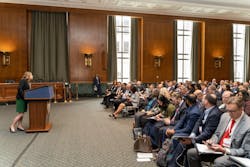Working to ensure adequate funding for safe, affordable water
As the nation’s water and wastewater treatment systems of pipes, pumps, and plants reach the end of their intended lifespan, investing in water infrastructure has dominated the utility landscape. In its most recent report card (2017), the American Society of Civil Engineers gave water infrastructure in the United States a D grade and the nation’s wastewater infrastructure a D+.
According to the US Water Alliance, 85 percent of Americans support increasing federal investment to rebuild our water infrastructure, yet there remains a significant funding gap between the amount of federal funds available and how much utilities and municipalities will need to ensure public health and safety in the coming years. In fact, the American Water Works Association (AWWA) estimates drinking water systems need to invest $1.7 trillion in infrastructure over the next 40 years, and the Environmental Protection Agency’s (EPA) needs survey estimates the United States will require $271 billion for wastewater and stormwater needs over the next 20 years.
“Federal funding for water and wastewater has been on the increase in recent years,” Kristina Surfus, managing director of government affairs at the National Association of Clean Water Agencies (NACWA), said. “We’ve seen some continued increases in funding for core programs like the State Revolving Funds. But the federal funding that exists is still a really small portion of overall investment in water and wastewater in this country. More than 90 percent of funding for water and wastewater infrastructure is now local or state dollars. So, the federal share is quite small.”
Surfus also noted that federal funding has come from loans rather than grants, which puts the burden on the ratepayer, something NACWA is working with lawmakers to change. She noted that although these loans help communities get low interest rates, it “exasperates the burden for local rate payers. [While] we’re glad that the funding has gone up in recent years, there is a lot more need. And on top of traditional needs like aging infrastructure, we’ve got growing new challenges.” These include things like adapting to a changing climate and how utilities are trying to make investments to make their systems more resilient, she noted. “Those costs are only going to continue to grow, and there is no real federal support for that.”
As communities grapple with financing traditional repairs and upgrades, there are growing new challenges that seek to deplete the overall funding available for ensuring our nation’s water supply is clean and reliable. Treatment for emerging contaminants, like per- and polyfluoroalkyl substances (PFAS), impose new costs for already cash-strapped utilities trying to clean up and treat these chemicals on the front lines. And while the burden has fallen on local governments, several water advocacy groups are working with Congress to change that.
For its member utilities, NACWA has provided a resource, A Clean Water Utility’s Guide to Considering Source Identification, Pretreatment, and Sampling Protocols for PFAS, to help navigate response to growing federal and state regulations. Similarly, the AWWA Briefing on PFAS is a free guide for water professionals, providing information and action items for addressing PFAS contamination in their communities.
As the guide states, “More funding for research is needed to assess and address the human health effects of exposure to PFAS; identify analytical methods that quantify levels of PFAS in source water, drinking water and wastewater; and further develop technologies to cost-effectively remove PFAS compounds to levels that do not post health concerns.”
The Water Environment Federation (WEF) has been working on advancing a coalition effort between water sector associations, biosolids programs and solid waste organizations through a collaborative effort called the PFAS Receivers Group. “These are the agencies and organizations that are receivers of PFAS, including drinking water and wastewater treatment plants, biosolids facilities and solid waste facilities,” Steve Dye, legislative director with WEF, said. “[While] this is an informal coalition, we want to make sure that we are all talking to each other because we will all be impacted with whatever path this [cleanup] takes on a federal policy level.”
To that end, WEF has produced an outline of the PFAS problems and challenges from the municipal water management perspective and is using it to educate lawmakers on Capitol Hill.
“Among our many recommendations to Congress is to give more robust support to developing the science, through EPA and stakeholders, to have good policy [around PFAS management], but in the meantime, keep moving forward with policy, [allocating] more funding to help communities address these challenges with cleanup or investments in treatment technologies if necessary,” Dye said.
When it comes to PFAS cleanup, “local innocent rate payers and utilities should not be on the hook for those kinds of costs,” Surfus said.
Her sentiment is echoed by Dye, who added that the burden for cleanup costs should fall to the producers and users of PFAS chemicals. “They may or may not have known what the impacts of PFAS are for public health and the environment, but they are the sources of PFAS in our communities, so they need to be held accountable for the costs that are going to be incurred for this major cleanup that is going to be forthcoming and ongoing,” he said.
As water and wastewater rates continue to rise (some reports show rates have been rising faster than the rate of inflation for almost two decades), affordability is another growing concern for water groups.
“Obviously [rising rates] have an impact on all rate payers,” Surfus said. “But it’s becoming particularly acute for low-income rate payers in a lot of communities where the cost of these vital services has just gone up and up.” She emphasized that utilities are doing everything they can to keep rates low but also need to make these needed investments.
One piece of legislation that could help close the funding gap is House Bill 1497, or the Water Quality Protection and Job Creation Act of 2019. Introduced by Rep. Peter DeFazio (D-OR), the bill will reauthorize and increase funding for the Clean Water State Revolving Fund (SRF), as well as a number of other core EPA programs.
“This is important because the authorization for the SRF expired a couple decades ago, and it continues to get funding. But it’s well overdue to be looked at again by Congress. And NACWA is advocating for significantly higher funding levels, as well as some targeted policy reforms to help communities make their investments and keep water rates a little more affordable [for rate payers],” Surfus said.
WEF worked with Congressman Greg Stanton (D-Ariz.) on a provision in the bill that supports water workforce needs. “[It] gives states the authority to set aside one percent of their federal capitalization grant to go toward workforce development programs,” Dye said.
“The senate is going to be working on its Water Resources Development Act (WRDA) for 2020 this year, and so we’re seeing if maybe it could get packaged as part of that effort,” Surfus said.
In February 2020, the Trump Administration released its proposed budget, which cuts $2.5 billion from federal water infrastructure programs, including those overseen by EPA.
The Administration’s spending proposal for fiscal year 2021 proposes to cut federal grants to capitalize state revolving funds (SRFs) by 28 percent, taking total funding for Clean Water Act SRF grants down to $1.12 billion and the Safe Drinking Water Act grants to $863 million. The Trump budget proposal also calls for WIFIA loan program funding to be cut down to $20 million from last year’s $55 million. However, Surfus remains optimistic that the preliminary budget numbers will not stick.
“We know that while [this budget] is a statement of the administration’s principles, Congress has historically pushed back on [cuts to water programs] and actually put forward pretty strong budgets regardless of what we’ve seen with the president’s initial proposal,” she said. “We are confident that Congress understands that there needs to be more funding provided for water infrastructure. And so, we’ll be working with congress to get those funding levels restored for Fiscal Year ‘21.”
Dye adds that WEF is hopeful that Congress will continue to increase funding to programs for water infrastructure moving forward. “There are lots of benefits that can be found with increased funding, from improved water quality to job creation,” he said. “So, if congress can find the funding and resources for financing [infrastructure improvements], we believe that there can be great strides.” WW
About the Author

Alanna Maya
Chief Editor
Alanna Maya is a San Diego State University graduate with more than 15 years of experience writing and editing for national publications. She was Chief Editor for WaterWorld magazine, overseeing editorial, web and video content for the flagship publication of Endeavor's Water Group. In addition, she was responsible for Stormwater magazine and the StormCon conference.


